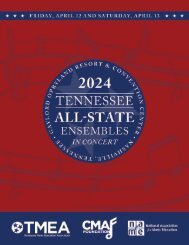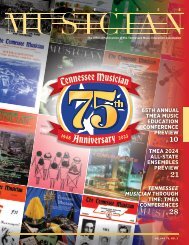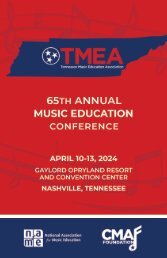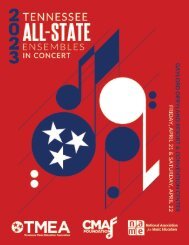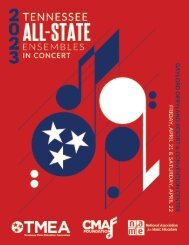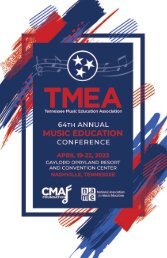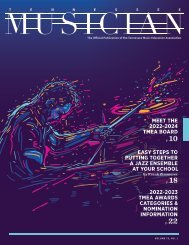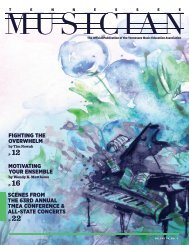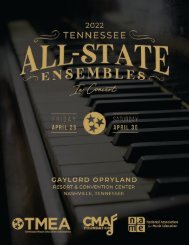You also want an ePaper? Increase the reach of your titles
YUMPU automatically turns print PDFs into web optimized ePapers that Google loves.
a conductor might make for beautiful music, but it<br />
doesn’t reach the higher levels of evaluating, analyzing<br />
and creating.<br />
The National Core Arts Standards (2014), or<br />
NCAS, aim to help our students get there. What is the<br />
basis for the new standards? The NCAS were based<br />
upon the curricular model “Understanding by Design”<br />
by Williams and McTighe (2005). This model advocates<br />
for “backward design,” which means beginning<br />
your lesson planning with expected outcomes, and<br />
ending by choosing activities that will help the students<br />
achieve those outcomes. The NCAS<br />
also uses the language from Williams and McTighe<br />
when categorizing the standards, which I will explain<br />
later in this article.<br />
The NCAS were written with 21st Century<br />
Skills in mind. You probably have heard this term<br />
thrown around before, but what exactly are 21st century<br />
skills? These were coined by the Partnership for<br />
21st Century Skills (2002), a conglomerate of U.S.<br />
companies that seeks to create future employees that<br />
will compete in the global marketplace. These skills<br />
are: Critical thinking and problem solving,<br />
Creativity and innovation, Communication and collaboration,<br />
and Cross-disciplinary thinking. One of<br />
the goals of the NCAS is to develop these skills in our<br />
students so they can be successful, not only in music,<br />
but in life.<br />
The NCAS writing team recognized the variety<br />
of ways that music instruction is being delivered in<br />
schools across the country, and organized the standards<br />
around several areas of study: Music (general),<br />
Harmonizing Instruments, Composition and Theory,<br />
Traditional and Emerging Ensembles, and Technology.<br />
This means that the general music teacher who sees<br />
her students once a week for thirty- minutes will have<br />
a unique set of standards for her students, as will the<br />
high school band director who sees his students for an<br />
hour and a half every day, as will the middle school<br />
guitar ensemble teacher. There are, however, some<br />
things that are common across the areas. The NCAS<br />
are based on four Common Anchor Standards: Create,<br />
Perform, Respond and Connect.<br />
- Continued on Page 49<br />
Compose Your Future<br />
Bachelor of Music Degrees in Performance and Education Accredited<br />
by the National Association of Schools of Music<br />
Nationally recognized traditional, jazz, and contemporary ensembles<br />
Competitive scholarships that can provide full tuition based on audition<br />
PO Box 70661 • Johnson City, TN • 423-439-4270 • www.etsu.edu/music<br />
29



